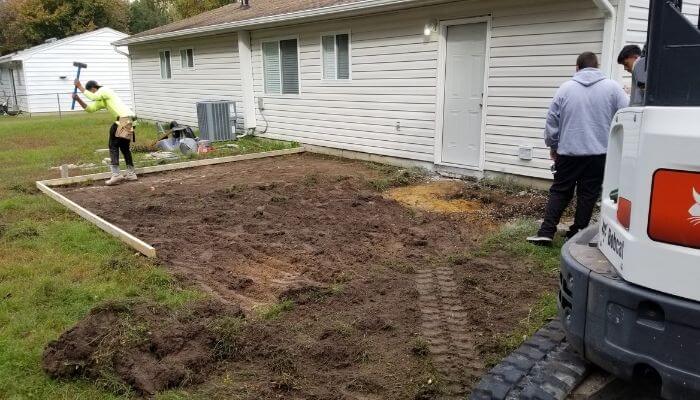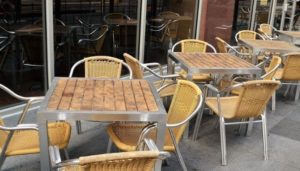I’ve had people ask which material is best for their outdoor space. They ask about concrete vs. pavers, concrete vs. wooden decks, composite decks vs. flagstone patios, and so on and so forth. But the answer can be subjective.
Concrete is the most durable and least expensive patio material and also boasts minimal maintenance over its lifetime. It’s very practical, but without additional designs and colors is very plain. It may not be a fit for your design or the style you want to convey in your outdoor space.
If you’d like to see more comparisons between patio materials like pavers & brick, flagstone, composite decks, and wooden decks, along with some fun facts and ideas, keep reading!
What Are The Differences Between Types of Patios?
So, let’s get this out of the way first. If we have a table for comparison that shows the standard price per square foot, including labor for each material and also the durability and relative maintenance needed, you might be surprised. I know I was.
I always had this misconception that concrete costs more. And I was wrong. We actually went with a concrete patio in this outdoor space we currently have and we also had a slab back in 2009. This was our first home. If you want to know more about concrete, check out our article talking about if a concrete patio is right for your outdoor living space.
We’ve had every kind other than the intricately designed concrete and the composite wood.
| MATERIAL | COST to BUILD (per sqft) | LIFESPAN | MAINTENANCE |
|---|---|---|---|
| concrete | $6 – $10 | 30 – 50+ years | minimal |
| intricate design concrete | $15 – $20 | 30 – 50+ years | minimal |
| wood | $18 – $28 | 10 – 15 years | annual |
| composite wood | $20 – $38 | 25 – 30 years | minimal |
| pavers/brick | $9 – $23 | 25 – 35 years (but joints will be less) | minimal(joints?) |
| flagstone | $15 – $21 | 35+ years (but joints will be less) | minimal (joints?) |
You may look at the lifespan stats and want to argue, considering there are homes made of brick that are well over a century old and driveways, stoops, and patios made of concrete, stone, and brick that are still being used over 50 years after installation.
The lifespan is not about how long the material can last under perfect conditions. It’s about how long it will take before wear and tear in the natural elements and accidental defects cause the patio made of this material to deteriorate enough that the owner will want to replace it.
As I mentioned above, we have already covered concrete in another article. So, let’s dive into each type of patio material other than concrete, and hopefully, you’ll have a better idea about what to choose for your outdoor space.
What Are Some Reasons To Choose A Wood Deck?
In our area, there is a new trend in design that is modern and highly influenced by Eastern residential, particularly Japanese residential styles. I’ve seen a lot of houses, designed in the standard brick ranch style, transformed into this new style over the last seven years. And with that new style comes a desire for wood (especially natural wood) decks.
As I mentioned, wood decks aren’t the practical choice, especially right now when there is a supply chain issue and wood has skyrocketed in cost. However, wood may be exactly the style that’s needed for completing the design preference for your outdoor living space.
If your decision to use wood is also based on turnaround value, choosing wood decking has a good immediate return on investment should you be in the market for selling your home and want to add something that increases the value. However, in the long term, that value can dwindle. Wooden decking requires cleaning, staining, and constant lookout for rotten wood that needs to be replaced.
That’s why you might find the best benefit in researching a plastic-wood composite that requires less maintenance and lasts longer than wood. The initial cost is higher, but if you’re not planning to sell the property soon, this would be a sound decision.
Pavers, Flagstone, or Brick? Which Is Best For Your Patio?
They install these patio materials on the ground level of your outdoor space, no matter which you choose. Otherwise, a raised foundation will have to be considered – which can cost a bit more money and take a bit more time.
If you want a long-term return on investment, using pavers, brick, or flagstone to create a patio for your outdoor space can be a great value. In the long term, these patios last longer than wood and require less maintenance.
From a design perspective, pavers, brick, and flagstone are going to integrate better than wood with other elements in your outdoor space. You can incorporate elements like fire pits, kitchens, fountains, and further plant landscaping into the patio made of these materials. Pavers can emulate the look of natural stone. Once they’re placed, no one will really know the difference and it could save you some money.
Using flagstone instead of pavers is entirely different. Flagstone is a natural stone – not manufactured. That means it costs more and that you should probably take a bit of personal responsibility in making sure your flagstone came from a reputable source that uses sustainable quarrying and handling practices.
It’s usually more expensive and requires professional installation. Why? Because natural stone doesn’t have consistent shapes or sizes. Therefore, it’s not even in-depth. So, your stonemasons or designers have to shape and fit the stones on-site.
Pavers will be more durable and easier to replace than flagstones. But if you want a truly unique feature in your outdoor space, flagstones will give that to you.
Concrete Made To Look Like Flagstone And Pavers
Did I say I wouldn’t mention concrete, because there was an entire article for that? Well, I lied. We are covering pavers, brick, and flagstone as style options for your outdoor living space. So, it’s only fair to mention that concrete can emulate those materials.
You can still make a visual impact with concrete, so long as you choose the right contractor. And the cost of this is on average the same if not less than having your patio or deck made of the other materials I’ve mentioned in this article.
Professionals can stencil concrete, hand-carved, colored, and bordered in a way that it takes on the look of flagstone or pavers. So, keep that in mind when you make your decision.
What Do You Want From Your Outdoor Space?
It’s something you should decide before you begin. Sometimes people actually hire landscape designers to help them over this hump. After all, why invest a lot in your patio if you won’t use it? Here are some questions that most landscape designers will ask:
- Does my outdoor space flow with the design of my home? Do I want it to?
- Does my outdoor space provide for the activities my family enjoys?
- Do I like the plants and their arrangement in my landscape?
- Do I have enough privacy?
Once you answer these questions, a professional landscape designer can then get more specific about what you want to see and experience in your outdoor spaces. They can help you plan out what materials would work best for the style you want. The most important of which is the material you need as the foundation of your outdoor space.
Usually, they can provide the installation services or they can point you in the right direction of those services. If you are into the DIY spirit, the designer can provide you with the plans to go by. Perhaps you don’t even need the help of a landscape designer – and that’s okay.
If you want to tackle all of this yourself, I hope that my blog and this article can help you along your journey. Maybe you’ve been able to look through my article and get an already decent idea about what patio materials you’d like to try.














